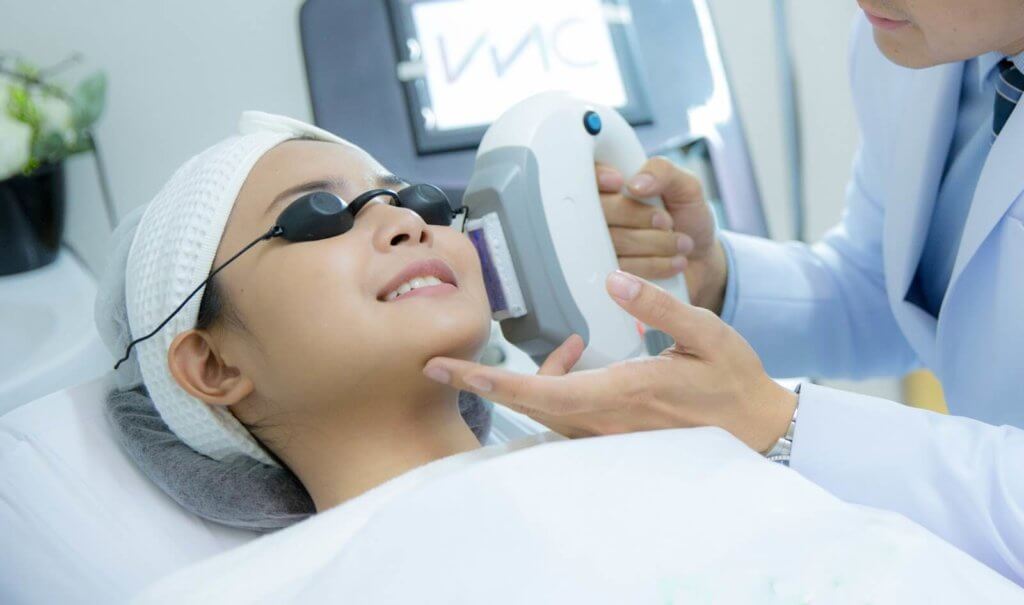Shaving, waxing, and tweezing often feel like losing battles. You get rid of a hair one day, but a few days later, it’s back and you have to address it again.
If you’re sick of wasting time dealing with unwanted hair growth, you might want to consider permanent hair removal.
When it comes to removing hair permanently, you have two options:
Laser hair removal or electrolysis.
But what’s the difference between the two? Is one better than the other? Which one is right for you?
Today, we’re discussing electrolysis versus laser hair removal to help you make the right choice.
How Laser Hair Removal Works
 |
| Electrolysis vs. Laser Hair Removal |
Before you can decide which hair removal treatment is the better option, you should know how each process works.
When you undergo laser hair removal, a technician applies a pulse of light into your pores. The light energy travels through your skin, targeting the melanin in your hair follicle. By increasing the temperature of the follicle, it destroys the root of the hair.
When the root is destroyed, the follicle is unable to produce hair.
Laser Hair Removal Aftercare
To see the best results, you must follow an aftercare treatment routine. You’ll need to limit sun exposure for several weeks and wear loose clothing for at least two days after treatment. Also, it’s best to avoid swimming pools, hot tubs, steam rooms, and physical exercise for 48 hours.
Other than that, you can go about your daily activities as usual.
Side Effects of Laser Removal
Laser hair removal has limited side effects. Some people experience redness and swelling, but those usually subside within a few hours.
Afraid that it might hurt? Most people say that the pain is minimal and that the laser feels like snapping a rubber band against the skin.
How Electrolysis Works
 |
| Electrolysis vs. Laser Hair Removal |
Electrolysis involves the insertion of an ultra-thin needle (called a probe) into an individual hair follicle. The probe sends an electric current through the follicle, damaging it so that future hair growth cannot occur.
Individual hairs are targeted one at a time.
Electrolysis Aftercare
After electrolysis, you’ll have to apply an antibacterial cream to the treated areas. You should avoid any activity that could cause you to sweat excessively.
You’ll also need to avoid touching or scratching the treated area in the days following treatment.
Side Effects of Electrolysis
Some people see small scabs on the surface of the skin, but they fall off naturally. It’s also common to see redness and swelling for a few hours after treatment.
Patients report small amounts of pain during the process, too. Most people describe the feeling as a heat sensation followed by a pinch each time the needle attacks a new follicle.
The Similarities Between Electrolysis and Laser Hair Removal
 |
| Electrolysis vs. Laser Hair Removal |
Electrolysis and laser hair removal are similar in several ways:
Both Can Remove Hair From Anywhere on the Body
Both treatments are effective on the bikini line, underarms, nose, ears, and upper lip. They also work well on large areas such as the back, arms, and legs.
Anyone can get either procedure, but you should speak to a dermatologist first to make sure you’re a good candidate for treatment.
Both Require Multiple Sessions
Hair growth involves three stages. Laser hair removal and electrolysis only work when the hair follicle is in the anagen, or growth phase.
Multiple sessions are necessary to capture every hair in that specific phase.
Both Are Safe and Effective
Both methods are safe and FDA-approved for permanent hair removal. They both eliminate the need to shave and wax and can prevent ingrown hairs.
However, in order for either technique to be effective, it must be performed by a professional.
The Differences Between Electrolysis and Laser Hair Removal
Although these two hair removal methods share some similarities, they also have some differences:
Laser Hair Removal Requires Fewer Sessions
Multiple sessions are necessary, regardless of which method you choose. However, electrolysis sessions are longer, and you’ll need to have more of them.
Laser hair removal usually requires four to eight sessions. The exact number depends on your skin type, pigmentation, hair color, and the size of the area.
Electrolysis, on the other hand, can take up to 30 sessions, especially in an area where the hair is coarse.
With laser hair removal, you’ll need to do a touch-up treatment about once a year. Electrolysis doesn’t require any follow-up (unless you experience an infection).
Laser Hair Removal Sessions Are Shorter
Laser hair removal treatments last only a few minutes each, as the laser affects multiple hairs at one time.
Electrolysis sessions are much longer, as every hair must be targeted one at a time. They happen every week or two, making it a much more time-consuming process.
Electrolysis vs. Laser Hair Removal: Which One is Better?
 |
| Electrolysis vs. Laser Hair Removal |
So is one method better than the other? It all depends on what you’re looking for.
Here are some additional facts to help you make your decision:
Electrolysis costs less money per session. However, you’ll need more sessions to get rid of your body hair. You might be able to get away with just a few sessions on small areas of the body, but larger areas can get quite expensive.
Laser hair removal treatment usually costs more per session, but it takes only a few sessions to see results. Prices vary for both, depending on the size of the treatment area.
If you’re concerned about pain, both procedures can be uncomfortable. Most people experience minor discomfort during laser hair removal, but each session only lasts a few minutes.
Electrolysis can be painful too, and sessions are longer. Therefore, you’ll experience discomfort for a longer period of time.
Electrolysis has the same effect on any hair type and any skin color. Laser treatment is most effective on people with light skin and dark hair or vice versa.
You’ll have to decide for yourself which method of hair removal you want to go with. It’s best to start the process by talking with your dermatologist.
Regardless of which one you choose, make sure to have the procedure performed by a licensed, certified technician. That’s the only way to protect yourself and ensure the best possible results.

0Comments